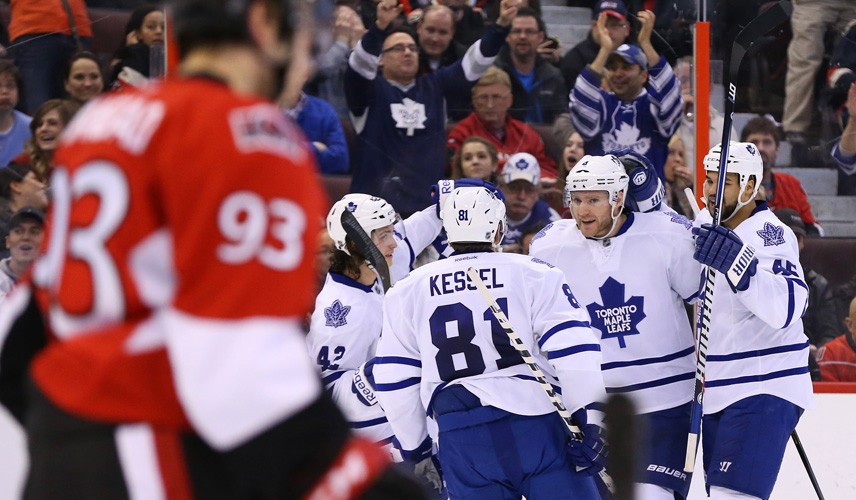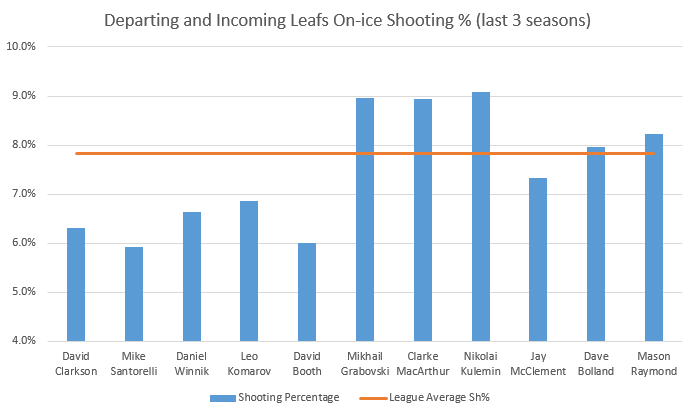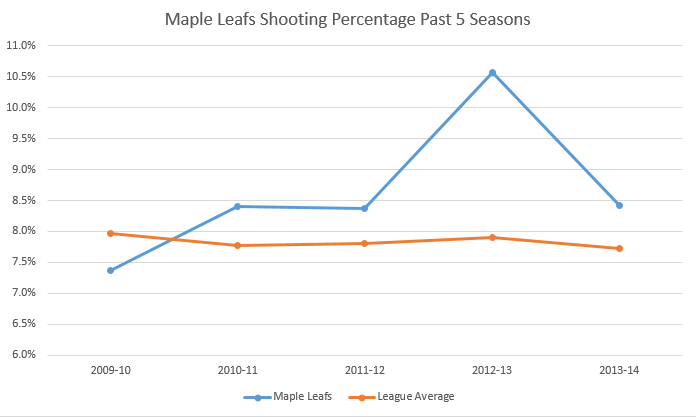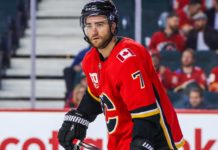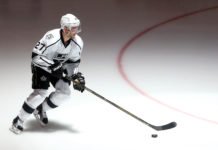Over the past two off seasons, the Toronto Maple Leafs have made a fairly significant number of moves to their group of forwards beyond their core of Kessel, JVR, Bozak, Lupul and Kadri.
Significant forwards gone from the 2011-12 season are Mikhail Grabovski, Clarke MacArthur, Nikolai Kulemin and JayMcClement, while Dave Bolland and Mason Raymond are gone from last season. Incoming forwards the past two off seasons are David Clarkson, Mike Santorelli, Daniel Winnik, David Booth, and Leo Komarov will return to the Leafs after a season in the KHL. The following table shows some key stats for all these players over the past 3 seasons:
| Player | CF% | TMCF% | CF% - TMCF% | Sh% | |
|---|---|---|---|---|---|
| Joining Leafs | David Clarkson | 50.2 | 49.2 | 1.0 | 6.31 |
| Mike Santorelli | 50.5 | 50.7 | -0.2 | 5.92 | |
| Daniel Winnik | 50.3 | 49.2 | 1.1 | 6.63 | |
| Leo Komarov | 45.7 | 46.2 | -0.5 | 6.86 | |
| David Booth | 55.0 | 53.6 | 1.4 | 6.01 | |
| Departing Leafs | Mikhail Grabovski | 50.4 | 46.2 | 4.2 | 8.96 |
| Clarke MacArthur | 52.0 | 48.3 | 3.7 | 8.93 | |
| Nikolai Kulemin | 44.8 | 46.9 | -2.1 | 9.09 | |
| Jay McClement | 41.2 | 47.2 | -6.0 | 7.33 | |
| Dave Bolland | 47.2 | 53.0 | -5.8 | 7.96 | |
| Mason Raymond | 47.3 | 48.4 | -1.1% | 7.96 |
CF% is corsi percentage while TMCF% represents how their teammates performed when they were not on the ice with these players. By looking at the difference (CF%-TMCF%), we can get an idea of how much impact they had on their teammates corsi percentage. Generally speaking, the guys coming in have a mostly neutral to slightly positive impact on their teammates corsi percentage. The departing players range from having a significantly positive impact in Grabovski and MacArthur, to significantly negative impact in McClement and Bolland, to a slightly negative impact in Kulemin and Raymond. Overall it’s probably a bit of a wash, but the group coming in is more balanced — probably a good thing.
What has me most concerned, though, is the impact it could have on the teams shooting percentage, which has generally been above league average. Every player the Leafs have brought in (or brought back in the case of Komarov) have had well-below-average in on-ice shooting percentage (league average is ~7.8% over past 3 seasons), while the majority of players leaving have had well above average on-ice shooting percentage. The following chart shows this nicely.
There are 365 forwards who have played at least 1000 minutes during 5v5 play over the past three seasons. Of those forwards, Daniel Winnik ranks 285th, Clarkson 306th, Booth 326th and Santorelli 332nd in on-ice shooting percentage. This translates into rankings of 268th, 294th, 284th and 295th respectively in goals for per 20 minutes of ice time. These guys will not produce much offense and the Leafs team shooting percentage is likely to continue to drop from it’s peak in 2011-12, the season when it boasted eight very good shooting percentage players (Kadri, JVR, Bozak, Lupul, Grabovski, MacArthur, Kulemin and Kadri). Three of those eight are now gone and replaced with well below average shooting percentage players; as a result, we could see the Leafs shooting percentage drop, possibly close to or maybe even slightly below average.
This will have a negative impact on the Leafs‘ overall goal production. The top lines will still score, but as bad as the bottom six was last season, how much offense can we really expect from the bottom two lines? They have lost a lot of offensive skill the past couple seasons and not replaced it (unless William Nylander can be a surprise and make a significant impact as an 18 year old). The hope is that those new guys will provide the team with better defense, but will it be enough to offset the drop in offensive production? I am not certain.











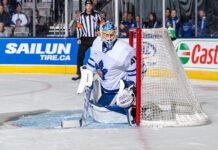


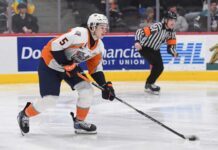
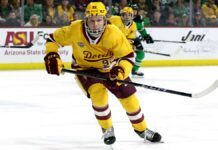

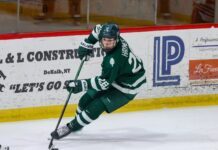




![Two Down, Two to Go for the Maple Leafs – MLHS Podcast EP91 [Now with Video]](https://mapleleafshotstove.com/wp-content/uploads/2025/04/maxresdefault-3-218x150.jpg)
